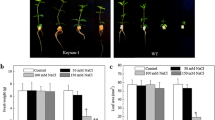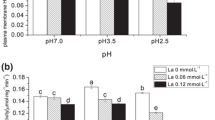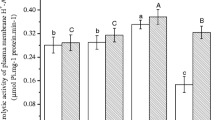Abstract
The plasma membrane H+-ATPase (PM H+-ATPase, EC.3.6.1.35) plays a key role in the plant response to environmental stress. In this study, a possible mechanistic link between the PM H+-ATPase and salicylic acid (SA)-induced thermotolerance was investigated in pea (Pisum sativum L. cv. NingXia) leaves. The burst of free SA in response to heat acclimation (38 ± 0.5°C) was observed, and peaks appeared subsequently both in activity and amount of PM H+-ATPase in pea leaves during heat acclimation. Similarly, exogenous SA also triggered the two peaks in the room temperature (25 ± 0.5°C). Paclobutrazol (PAC) was employed to infiltrate onto pea leaves prior to heat acclimation treatment. The results showed that the peaks of both free SA and activity of PM H+-ATPase still occurred after the PAC pretreatment. In acquired thermotolerance assessment (malondialdehyde content and degree of wilting), spraying SA and fusicoccin (FC, the activator of PM H+-ATPase) separately could protect pea leaves from heat injury. Results from RT-PCR and western blotting analysis indicated that the increase in activity of the PM H+-ATPase was due to its transcriptional and translational regulation. The subcellular localizations of PM H+-ATPase after the FC or SA pretreatment also showed that the PM H+-ATPase is important to maintain the integrity of plasma membrane against the heat stress. Taken together, these results suggest PM H+-ATPase is related to the development of SA-induced thermotolerance in pea leaves.







Similar content being viewed by others
Abbreviations
- DTT:
-
Dithiothreitol
- FC:
-
Fusicoccin
- MDA:
-
Malondialdehyde
- NBT/BCIP:
-
Nitro blue tetrazolium/5-bromo-4-chloro-3-indolyl phosphate
- PAC:
-
Paclobutrazol
- PIP2-PLC:
-
Phosphatidylinositol-4, 5-bisphosphate-specific phospholipase C
- PM:
-
Plasma membrane
- PM H+-ATPase:
-
Plasma membrane H+-ATPase
- PMSF:
-
Phenylmethylsulfonyl
- PVPP:
-
Polyvinylpyrrolidone
- RT-PCR:
-
Reverse transcription-polymerase chain reactions
- SA:
-
Salicylic acid
- SAG:
-
Salicylic acid 2-O-β-D-glucose
- SAR:
-
Systemic acquired resistance
- TCA:
-
Trichloroacetic acid
References
Ahn JS, Im JY, Chung CG, Cho HB (1999) Inducible expression of plasma membrane H+-ATPase in the roots of figleaf gourd plants under chilling rot temperature. Physiol Plant 106:35–40
Ahn SJ, Sivaguru M, Osawa H, Chung GC, Matsumoto H (2001) Aluminum inhibits the H+-ATPase activity by permanently altering the plasma membrane surface potentials in squash roots. Plant Physiol 126:1381–1390
Alsterfjord M, Sehnke P, Arkell A, Larsson H, Svennelid F, Rosenquist M, Ferl RJ, Sommarin M, Larsson C (2004) Plasma membrane H+-ATPase and 14-3-3 isoforms of Arabidopsis leaves: evidence for isoform specificity in the 14-3-3/H+-ATPase interaction. Plant Cell Physiol 45:1202–1210
Ames BM (1966) Assay of inorganic phosphate, total phosphate and phosphatases. Methods Enzymol 8:115–118
Arango M, Gévaudant F, Oufattole M, Boutry M (2003) The plasma membrane proton pump-ATPase: the significance of gene subfamilies. Planta 216:355–365
Axelsen KB, Venema K, Jahn T, Baunsgaard L, Palmgren MG (1999) Molecular dissection of the C-terminal regulatory domain of the plant plasma membrane H+-ATPase AHA2: mapping of residues that when altered give rise to an activated enzyme. Biochemistry 38:7227–7337
Babakov AV, Chelysheva VV, Klychnikov OI, Zorinyanz SE, Trofimova MS, De Boer AH (2000) Involvement of 14-3-3 proteins in the osmotic regulation of H+-ATPase in plant plasma membrane. Planta 211:446–448
Baunsgaard L, Venema K, Axelsen KB, Villalba JM, Welling A, Wollenweber B, Palmgren MG (1996) Modified plant plasma membrane H+-ATPase with improved transport coupling efficiency identified by mutant selection in yeast. Plant J 10:451–458
Bradford MM (1976) A rapid and sensitive method for the quantitation of microgram quantities of protein utilizing the principle of protein-dye binding. Anal Biochem 72:248–254
Carratu L, Franceschelli S, Pardini CL, Kobayashi GS, Horvath I, Vigh L, Maresca B (1996) Membrane lipid perturbation modifies the set point of the temperature of heat shock response in yeast. Proc Natl Acad Sci USA 93:3870–3875
Chang A, Slayman CW (1991) Maturation of the yeast plasma membrane H+-ATPase involves phosphorylation during intracellular transport. J Cell Biol 115:289–295
Chelysheva VV, Smolenskaya IN, Trofimova MC, Babakov AV, Muromtsev GS (1999) Role of the 14-3-3 proteins in the regulation of H+-ATPase activity in the plasma membrane of suspension-cultured sugar beet cells under cold stress. FEBS Lett 456:22–26
Clarke MS, Mur AJL, Wood EJ, Scott MI (2004) Salicylic acid dependent signaling promotes basal thermotolerance but is not essential for acquires thermotolerance in Arabidopsis thaliana. Plant J 38:432–447
Coccetti P, Tisi R, Martegani E, Teixeira LS, Brandão RL, Castro IM, Thevelein JM (1998) The PLC1 encoded phospholipase C in the yeast Saccharomyces cerevisiae is essential for glucose-induced phosphatidylinositol turnover and activation of plasma membrane H+-ATPase. Biochim Biophys Acta 1405:147–154
Coote PJ, Jones MV, Seymour IJ, Rowe DL, Ferdinando DP, Mcarthur AJ, Cole MB (1994) Activity of the plasma membrane H+-ATPase is a key physiological determinant of thermotolerance in Saccharomyces cerevisiae. Microbiology 140:1881–1890
Dat JF, Foyer CH, Scott IM (1998) Change in salicylic acid and antioxidants during induction of thermotolerance in mustard seedlings. Plant Physiol 118:1455–1461
Delaney PT, Uknes S, Vernooij B, Friedrich L, Weymann K, Negrotto D, Gaffney T, Gut-Rella M, Kessmann H, Ward E, Ryals J (1994) A central role of salicylic acid in plant disease resistance. Science 266:1247–1250
Faraday CD, Spanswick RM (1992) Maize root plasma membranes isolated by aqueous polymer two-phase partitioning: assessment of residual tonoplast ATPase and pyrophosphatase activities. J Exp Bot 43:1583–1590
Fodor J, Gullner G, Adam AL, Barna B, Komives T, Kiraly Z (1997) Local and systemic responses of antioxidants to tobacco mosaic virus infection and to salicylic acid in tobacco. Plant Physiol 114:1443–1451
Hasegawa PM, Bressan RA, Zhu JK, Bohnert HJ (2000) Plant cellular and molecular responses to high salinity. Annu Rev Plant Physiol Mol Biol 51:463–499
Hays DB, Doa JH, Masona RE, Morgana G, Finlaysona SA (2007) Heat stress induced ethylene production in developing wheat grains induces kernel abortion and increased maturation in a susceptible cultivar. Plant Sci 172:1113–1123
Huang Y, Yang F (1996) Physical state change of phospholipids mediated by Na+ modulates activity and conformation of reconstituted mitochondrial F0-F1-ATPase. In: Yang F, Wang F (ed) Membrane lipid-protein interaction and its application in medicine and agriculture. Shandong Science Press, Jinan, China, pp 1–17
Kalampanayil BD, Wimmers LE (2001) Identification and characterization of a salt-stress-induced plasma membrane H+-ATPase in tomato. Plant Cell Environ 24:999–1005
Kasamo K (2003) Regulation of plasma membrane H+-ATPase activity by the membrane environment. J Plant Res 116:517–523
Kinoshita T, Nishimura M, Shimazaki K (1995) Cytosolic concentration of Ca2+ regulates the plasma membrane H+-ATPase in guard cells of fava bean. Plant Cell 7:1333–1342
Kratsch HA, Wise RR (2000) The ultrastructure of chilling stress. Plant Cell Environ 23:337–350
Kuhlbrandt W (2004) Biology, structure and mechanism of P-type ATPases. Nat Rev Mol Cell Biol 5:282–295
Laemmli UK (1970) Cleavage of structural protein during the assembly of the head bacteriophage T4. Nature 227:680–685
Lee HI, Raskin I (1998) Glucosylation of salicylic acid in Nicotiana tabacum cv. Xanthi-nc. Phytopathology 88:692–697
León J, Shulaev V, Yalpani N, Lawton MA, Raskin I (1995) Benzoic acid 2-hydroxylase, a soluble oxygenase from tobacco, catalyzes salicylic acid biosynthesis. Proc Natl Acad Sci USA 92:10413–10417
Liu HT, Huang WD, Pan QH, Weng FH, Zhan JC, Liu Y, Wan SB, Liu YY (2006a) Contributions of PIP2-specific-phospholipase C and free salicylic acid to heat acclimation-induced thermotolerance in pea leaves. J Plant Physiol 163:405–416
Liu HT, Liu YY, Pan QH, Yang HR, Zhan JC, Huang WD (2006b) Novel interrelationship between salicylic acid, abscisic acid and PIP2-specific-phospholipase C in heat acclimation-induced thermotolerance in pea leaves. J Exp Bot 57:3337–3347
Logemann J, Schell J, Willmitzer L (1987) Improved method for the isolation of RNA from plant issues. Anal Biochem 163:16–20
Mauch-Mani B, Métraux J (1998) Salicylic acid and systemic acquired resistance to pathogen attack. Ann Bot 82:535–540
Michelet B, Boutry M (1995) The plasma membrane H+-ATPase: a highly regulated enzyme with multiple physiological functions. Plant Physiol 108:1–6
Morsomme P, de Kerchove d’Exaerde A, De Meester S, Thines D, Goffeau A, Boutry M (1996) Single point mutations in various domains of a plant plasma membrane H+-ATPase expressed in Saccharomyces cerevisiae increased H+ pumping and permit yeast growth at low pH. EMBO J 15:5513–5526
Olsson A, Svennelid F, EK B, Sommarin M, Larsson C (1998) A phosphothreonine residue at the C-terminal end of the plasma membrane H+-ATPase is protected by fusicoccin-induced 14-3-3 binding. Plant Physiol 118:551–555
Ottmann C, Marco S, Jaspert N, Marcon C, Schauer N, Weyand M, Vandermeeren C, Duby G, Boutry M, Wittinghofer A, Rigaud J-Louis, Oecking C (2007) Structure of a 14-3-3 coordinated hexamer of the plant plasma membrane H+-ATPase by combining X-Ray crystallography and electron cryomicroscopy. Mol Cell 25:427–440
Palmgren MG (1998) Proton gradients and plant growth: role of the plasma membrane H+-ATPase. Adv Bot Res 28:1–70
Palva TK, Hurtig M, Saindrenan P, Palva ET (1994) Salicylic acid induced resistance to Erwinia carotovora subsp. Carotavora in tobacco. Mol Plant Microbe In 7:356–363
Pan QH, Zhan JC, Liu HT, Zhang JH, Chen JY, Wen PF, Huang WD (2006) Salicylic acid synthesized by benzonic acid 2-hydroxylase catalysis was involved in the induction of thermotolerance in pea plants. Plant Sci 171:226–233
Pastori GM, Foyer CH (2002) Common components, networks and pathways of cross-tolerance to stress: the central role of ‘redox’ and abscisic acid-mediated controls. Plant Physiol 129:460–468
Peng YB, Lu YF, Zhang DP (2003) Abscisic acid activates ATPase in developing apple fruit especially in fruit phloem cells. Plant Cell Environ 26:1329–1342
Portillo F (2000) Regulation of plasma membrane H+-ATPase in fungi and plants. Biochim Biophys Acta 1469:31–42
Prince AH, Hendry GAF (1991) Iron-catalyzed oxygen radical formation and its possible contribution to drought damage in nine native grasses and three cereals. Plant Cell Environ 14:451–477
Rao MV, Davis KR (1999) Ozone-induced cell death occurs via two distinct mechanisms in Arabidopsis: the role of salicylic acid. Plant J 17:603–614
Rao MV, Paliyath G, Ormrod P, Murr DP, Watkins CB (1997) Influence of salicylic acid on H2O2 production, oxidative stress, and H2O2-metabolizing enzymes. Plant Physiol 115:137–149
Rasmussen JB, Hammerschimidt R, Zook MN (1991) Systemic induction of salicylic acid accumulation in cucumber after inoculation with Pseudomonus syringae pv. Syringae. Plant Physiol 97:1342–1347
Ruelland E, Campalans A, Selman-Housein G, Puigdomenech P, Rigau J (2003) Cellular and subcellular localization of the lignin biosynthetic enzymes caffeic acid-O-methyltransferase, cinnamyl alcohol dehydrogenase and cinnamoyl-coenzyme A reductase in two monocots, sugarcane and maize. Physiol Plant 117:93–99
Sangwan V, Örvar BL, Beyerly J, Hirt H, Dhindsa RS (2002) Opposite changes in membrane fluidity mimic cold and heat stress activation of distinct plant MAP kinase pathways. Plant J 31:629–638
Schaller A, Oecking C (1999) Modulation of plasma membrane H+-ATPase activity differentially activates wound and pathogen defense responses in tomato plants. Plant Cell 11:263–272
Senaratna T, Touchell D, Bunn T, Dixon K (2000) Acetyl salicylic acid (Aspirin) and salicylic acid induce multiple stress tolerance in bean and tomato plants. Plant Growth Regul 30:157–161
Serrano R (1983) In vivo glucose activation of the yeast plasma membrane ATPase. FEBS Lett 156:11–14
Shen H, He LF, Sasaki T, Yamamoto Y, Zheng SJ, Ligaba A, Yan XL, Ahn SJ, Yamaguchi M, Sasakawa H, Matsumoto H (2005) Citrate secretion coupled with the modulation of soybean root tip under aluminum stress: up-regulation of transcription, translation, and threonin-oriented phosphorylation of plasma membrane H+-ATPase. Plant Physiol 138:287–296
Shen H, Chen JH, Wang ZY, Yang CY, Sasaki T, Yamamoto Y, Matsumto H, Yan XL (2006) Root plasma membrane H+-ATPase is involved in the adaptation of soybean to phosphorus starvation. J Exp Bot 57:1353–1362
Souza MAA, Trópia MJ, Brandão RL (2001) New aspects of glucose activation of the H+-ATPase in the yeast Saccharomyces cerevisiae. Microbiology 147:2849–2855
Sun WN, Montagu VM, Verbruggen N (2002) Small heat shock proteins and stress tolerance in plants. Biochim Biophys Acta 1577:1–9
Sung JA, Yang JJ, Gap CC, Baik HC (1999) Inducible expression of plasma membrane H+-ATPase in the roots of figleaf gourd plants under chilling rot temperature. Physiol Plant 106:35–40
Suwastika IN, Gehring CA (1999) The plasma membrane H+-ATPase from Tradescantia stem and leaf tissue is modulated in Vitro by cGMP. Arch Biochem Biophys 367:137–139
Sze H, Li XH, Palmgren GM (1999) Energization of plant cell membranes by H+-pumping ATPase: regulation and biosynthesis. Plant cell 11:677–689
Vani B, Saradhi P, Mohanty P (2001) Alteration in chloroplast structure and thylakoid membrane composition due to in vivo heat treatment of rise seedlings: correlation with the functional changes. J Plant Physiol 158:583–592
Venema K, Palmgren MG (1995) Metabolic modulation of transport coupling ratio in yeast plasma membrane H+-ATPase. J Biol Chem 270:19659–19667
Veselov AP, Kurganova LN, Likhacheva AV, Sushkova UA (2002) Possible regulatory effect of lipid peroxidation on the H+-ATPase activity of the plasmalemma under stress conditions. Russ Plant Physiol 49:385–389
Vitart V, Baxter I, Doerner P, Harper JF (2001) Evidence for a role in growth and salt resistance of a plasma membrane H+-ATPase in the root endodermis. Plant J 27:191–201
Wang WX, Vinocur B, Shoseyov O, Altman A (2004) Role of plant heat-shock proteins and molecular chaperones in the abiotic stress response. Trends Plant Sci 9:244–252
Woloszynska M, Kanczewska J, Drabkin A, Maudoux O, Dambly S, Boutry M (2003) Function and regulation of the two major plant plasma membrane H+-ATPase. Ann N Y Acad Sci 986:198–203
Yang YL, Zhang F, Zhao MG, An LZ, Zhang LX, Chen NL (2007) Properties of plasma membrane H+-ATPase in salt-treated Populus euphratica callus. Plant Cell Rep 26:229–235
Zhang DP, Lu YM, Wang YZ, Duan CQ, Yan HY (2001) Acid invertase is predominantly localized to cell walls of both the practically symplasmically isolated sieve element/companion cell complex and parenchyma cells in developing apple fruits. Plant Cell Env 24:691–702
Zhang JH, Huang WD, Liu YP, Pan QH (2005) Effects of temperature acclimation pretreatment on the ultrastructure of mesophyll cells in young grape plants (Vitis vinifera L. cv. Jingxiu) under cross-temperature stresses. J Integr Plant Biol 47:959–970
Zhang JH, Liu YP, Pan QH, Zhan JC, Wang XQ, Huang WD (2006) Changes in membrane-associated H+-ATPase activities and amounts in young grape plants during the cross adaptation to temperature stresses. Plant Sci 170:768–777
Acknowledgments
We are grateful to Dr. R. Serrano and Dr. Jennifer Corrigan for their kindly providing the antibody against PM H+-ATPase and Hsps. This research was supported by the National Natural Science Foundation of China (Grant Numbers 30471192 and 30671468), Specialized Research Fund for the Doctoral Program of Higher Education of China (No. 20050019015) and The Significant Program of Beijing Municipal Science and Technology Commission (No. D07060500160701).
Author information
Authors and Affiliations
Corresponding author
Rights and permissions
About this article
Cite this article
Liu, Y., Liu, H., Pan, Q. et al. The plasma membrane H+-ATPase is related to the development of salicylic acid-induced thermotolerance in pea leaves. Planta 229, 1087–1098 (2009). https://doi.org/10.1007/s00425-009-0897-3
Received:
Accepted:
Published:
Issue Date:
DOI: https://doi.org/10.1007/s00425-009-0897-3




